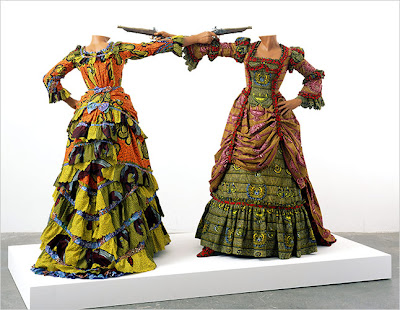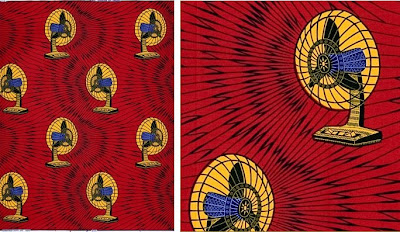









 At top, Yinka Shonibare How to Blow up two heads at once, 2006, incorporating Vlisco Dutch Wax fabric
At top, Yinka Shonibare How to Blow up two heads at once, 2006, incorporating Vlisco Dutch Wax fabricShonibare's work deals with post-colonial cultural amlgamations and cultural authenticity
All other images, Vlisco
I was vaguely familiar with what I thought of, generically, as African print cloth: bright–often harsh– color choices, large patterns. That was about the sum of my knowledge. I nearly gasped when I found out about Vlisco, the Dutch fabric company that produces* much of this wax print "African cloth." In Ghana, Ivory Coast and other West African countries, "Veritable Wax Hollandaise Vlisco" (Real Dutch Wax, Vlisco) carries the same cachet as Rolex or Louis Vuitton. Popular with the "Nana-Benzes," (ladies who favor their Mercedes) Vlisco evidently pairs well with their gold-framed eyeglasses, necklaces, and gold wristwatches.
How did a company in a small town in Holland become the major purveyor of quinessentially "African fabrics"? By way of Indonesia. Dutch traders discovered Indonesian dyed fabrics and imported them back to Europe. The van Vlissingens, a Dutch merchant family, had the idea that batik dying could be mass-produced in Europe and Vlisco was established on August 15, 1846. By the late nineteenth century Dutch factories were supplying the bulk of the Indonesian batik market, and as Dutch freighters stopped at various African ports on their way over, the fabrics began to gain an African clientele. West African soldiers serving in the East Indies also took to the fabrics and brought them back when they returned home. At the beginning of the twentieth century, when economic restrictions were enacted to protect domestic Indonesian batik production, Africa gradually became the exclusive market for Dutch batik. Central and West Africa in particular embraced the fabrics, integrating them into the local culture.

The prints are vivid, overscaled and exhilarating.
Many of the fabrics, though, feature incongruously representational—realistic—subject matter. It is this literalness that I find difficult to... parse. Vlisco has been showing up in Western fashion and now industrial and interior designers are incorporating it as well (see above). The fabric's use in nontraditional ways has a brio and irony that is ravishing. But with the wax print fabric's original colonial provenance in mind, out-sized patterns of table fans, video game control panels, wristwatches and richly outfitted kitchens veer uncomfortably close to 'naive' and 'totemic' for me. A kind of conflation of animist wish fulfillment and western status good. Rather than wearing the logo, wear (the representation of) the object itself— or a list of your favorite possessions.
Some background from the exhibit Fabric of a Nation: textiles and identity in modern Ghana held at the British Museum in 2007:
Wax prints are prestigious cloths with a high social value... Cloths are also widely used as a powerful mass communication media, for commemorative, political, religious, social and other message conveying purposes.Similarly a Vlisco press blurb offers this quasi mystical take on, essentially, wearable inventories of material goods:
This collection is a symbolic interpretation of crowning moments and treasured possessions. The designs reflect abstract objects and images that bring memories to life in vivid, fantastical form. Each fabric tells a colourful story of its own, personal to those who wear them and those who admire them. How looking through a key hole or ringing a door bell or taking a journey may have changed your destiny. How precious items or music may speak volumes to you alone. Each design evokes a personal, unique connection and bond. So, reflect upon your own journey.Surreal. Equal parts "shocking" Schiaparelli gesture, superstition, and status trade trinket...
* Some explanation of the process: Wax print fabrics are created with a resist-dye technique akin to Indonesian batik. Engraved copper rollers spread hot wax on both sides of a roll of fabric. The cloth is then dipped into a dye bath, color penetrating into the areas that are not covered with wax. (The sign of a quality wax print is that the cloth is printed on both sides.) The wax is washed off in varying stages and the process is repeated, layering the color prints. The technical difficulty in trying to align patterns in different colors gives the lesser quality productions a slightly haphazard organic quality. Colors that don't align properly come out looking like bad offset printing, which I find enormously appealing...
Addendum: interesting information and observations from someone familiar with some of the traditional fabrics in Africa (Thank you, Nina):
When we lived in Cameroon I collected a lot of cloth materials (called "pagnes" which is french for loincloth) but unfortunately the Chinese have now entered the market and are doing it much cheaper than anyone else. Subsequently people are buying it from them rather than the Dutch and the quality is entirely different. Also, because of the immense volume of used western clothing being shipped to Africa it is so much cheaper for people to buy western clothing instead of having things made out of the traditional cloth. That is also a reason for the decline. Here in Madagascar, except on the coasts, no one wears the traditional lamba material either. In the markets you can buy t-shirts, pants, shirts, etc. for pennies. It is a great pity. I miss a lot the color and mix of design from Central and West Africa. Something else that was also fun to see were the cloths printed for every occasion by businesses. The beer manufacturers, electric companies, etc. and bible verses, too, very popular.





10 comments:
You are amazing. If I were in charge, you'd be very rich and very famous.
xoo
How sweet thank you Carol.
(I wish you were in charge, heh!)
I love this post Angela!
Shonibare had a huge show at the Museum of Contemporary Art in Sydney last year and though I didn't get to Sydney I was lent the wonderful monograph on him.
That aside...what you have put together on this entire subject of the cloth and its origins is just brilliant. I will now have to put up a referring post to this post straight away to do it justice.
I studied 'Bahasa Indonesia' in early secondary school for a few years...in the 70's with Indonesia being one of our closest neighbouring countries this seemed quite sensible. We all learnt to make a most basic version of Batik in school. Enthusiastic travellers started bringing batik back here to sell around the same time...some of exquisite quality and eventually a great deal of kitch saturated the 'sarong' market here.
It was interesting for me to discover all to recently (such is our abysmal education of our indigenous history of this land) that there was an exchange going on between northern Australian indigenous people trading with Indonesians way before the British Settlement (Invasion as it is known in some parts) of Australia in 1788. I'm not sure at what stage Batik was taken up in various Aboriginal communities but it is firmly established as an art form in certain of the northern most areas on this Continent.
Such a pleasure to read your Blog Angela!
Offers excellent possibilities for some wild neckties.
BTW, congratulations on the reception. A book-signing indeed - outstanding!
Hi Angela,
I just found your blog. I too only recently became familiar with Vlisco. I thought all of these "african" fabrics were locally designed/produced. I have also read that there are no African designers working for Vlisco. That is such a shame! If you are selling to a poulation shouldn't you at least seek to employ them? I wanted to ask how much the Vlisco fabrics sell for in Madagascar? I saw on their site $70-120 US! I am just curious if it's an import thing that makes them so expensive here? Tks for your great blog and info.
Carol
Carol
I wonder about Madagascar-- a reader, Nina, has contacted me from there but I dont know the actual price tha Vlisco goes for there. I just go by what I read-- that it is a status item and is considered pricey.
On the site it was listed in Euros i think? 45- 60? It is VERY controversial, I would think, that there are no African designers working for them. That's why I think Yinka Shonibare's work with the fabrics is intriguing. thanks for yr comments!
Thanx for the link to Worn Through. Nice post.
Monica@wornthrough.com
Kitty and Angela:
YEAH. It's just like Mercedes Benz, Hermes, Marimekko, Prada, Louis Vuitton, Orrefors, and all those Swiss watch companies!
They should be sooooo embarrassed that they don't hire more Americans, given Americans buy so much of their products. This is soooooo CONTROVERSIAL. If you are selling to a population shouldn't you at least seek to employ them?
freat tissues!
The Recycled Paper Printing can also be used in order to overcome the difficulties as paper is manufactured from the bamboo plant and hence the plant has to be cut off.
Green Printing using Soy Inks
Post a Comment